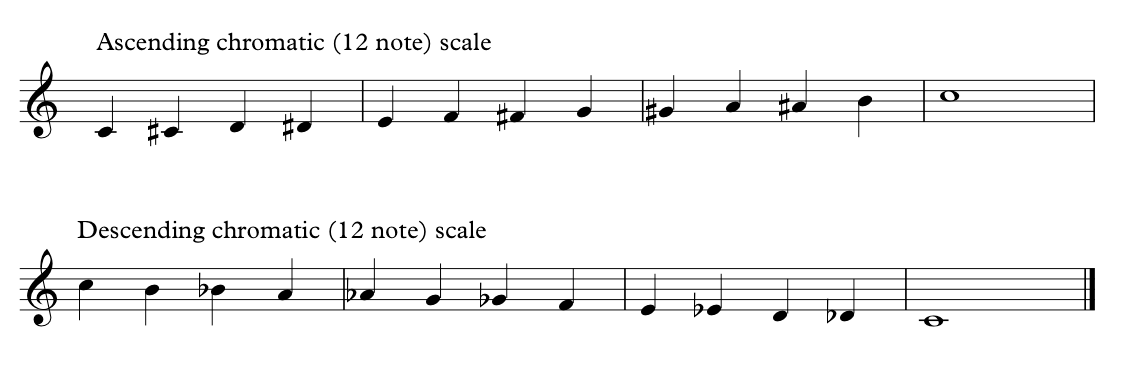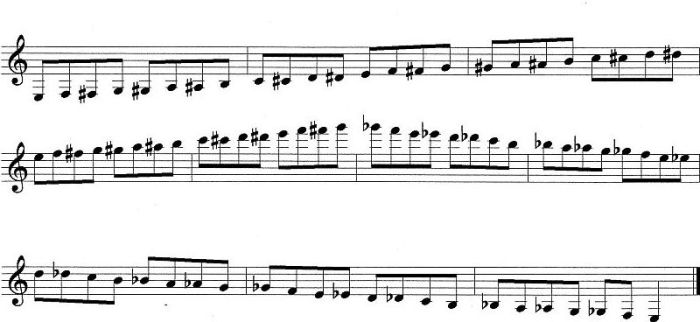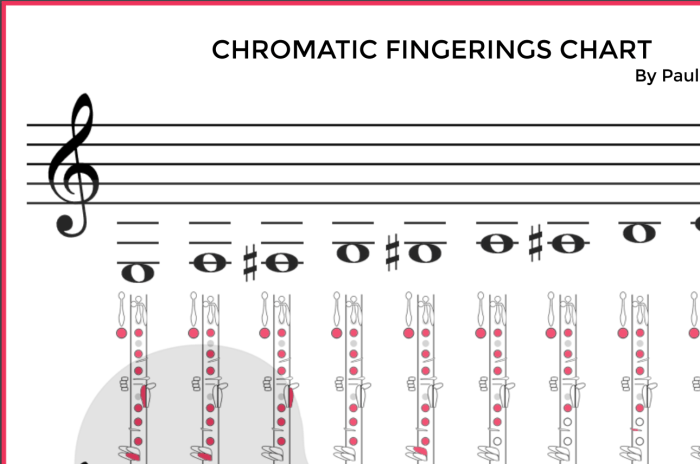Embark on a musical odyssey with the clarinet B flat chromatic scale, a gateway to unlocking the instrument’s expressive potential. From its intricate fingering patterns to its captivating applications in music, this scale holds the key to expanding your clarinet repertoire and captivating your audience.
Delve into the technicalities of the B flat clarinet, its history, and the intricacies of its key system. Discover the significance of the chromatic scale in music, its role in shaping melodies, and its ability to create tension and release.
Technical Overview of the Clarinet in B Flat

The B flat clarinet, also known as the standard clarinet, is a woodwind instrument renowned for its versatility and expressive capabilities. Its distinctive warm and mellow tone has made it a staple in various musical genres, from classical to jazz.The
B flat clarinet has a cylindrical bore and a single reed mouthpiece, producing a rich and sonorous sound. Its range spans three octaves and a sixth, from the low E♭ to the high C. The instrument’s key system, known as the Boehm system, facilitates chromatic playing and enables the execution of complex passages with ease.
History and Evolution
The clarinet’s origins can be traced back to the chalumeau, a primitive woodwind instrument popular in the 17th century. The development of the clarinet as we know it today is largely attributed to the German instrument maker Johann Christoph Denner, who refined its design and extended its range in the early 18th century.
Over the centuries, further improvements were made, culminating in the modern B flat clarinet, which has become a standard instrument in orchestras, bands, and solo performances.
Chromatic Scale on the Clarinet in B Flat: Clarinet B Flat Chromatic Scale

The chromatic scale is a fundamental musical concept that encompasses all twelve notes within an octave. It is significant in various musical genres, including classical, jazz, and contemporary music. For clarinetists, mastering the chromatic scale is essential for executing intricate passages, improvising solos, and achieving overall technical proficiency.
The clarinet in B flat has a chromatic scale that extends from the lowest note, E flat, to the highest note, G. To play the chromatic scale, simply follow the fingering chart and blow into the mouthpiece. You can also use the chromatic scale to create your own melodies and improvisations.
Just like how in basketball, there are cues to help you shoot the ball accurately, such as cues for shooting a basketball . Similarly, the chromatic scale provides cues for playing the clarinet.
Fingering Patterns
Playing the chromatic scale on the B flat clarinet involves a combination of regular fingerings and half-hole techniques. Here are the fingering patterns:
- C:Regular fingering
- C#:Half-hole on the first finger (left hand)
- D:Regular fingering
- D#:Half-hole on the second finger (left hand)
- E:Regular fingering
- F:Regular fingering
- F#:Half-hole on the third finger (left hand)
- G:Regular fingering
- G#:Half-hole on the fourth finger (left hand)
- A:Regular fingering
- A#:Half-hole on the first finger (right hand)
- B:Regular fingering
Exercises and Practice Techniques, Clarinet b flat chromatic scale
To master the chromatic scale, regular practice is essential. Here are some exercises and techniques:
- Slow and Steady:Begin by practicing the scale slowly, focusing on accuracy and finger placement.
- Gradually Increase Speed:As your accuracy improves, gradually increase the speed of your playing.
- Use a Metronome:A metronome can help you maintain a steady tempo and improve your timing.
- Record Yourself:Recording your practice sessions allows you to identify areas for improvement and track your progress.
- Chromatic Studies:Incorporate chromatic studies into your practice routine to challenge yourself and expand your technical abilities.
Musical Applications of the Chromatic Scale on the Clarinet

The chromatic scale, with its rich and versatile nature, offers a myriad of expressive possibilities for the clarinet. It can be employed to enhance melodic lines, create tension and release, and add depth and complexity to harmonies.
Melodic Embellishments
The chromatic scale provides a wealth of notes that can be used to embellish melodic lines, adding interest and variety. Grace notes, trills, and turns can be incorporated into passages to create a sense of movement and fluidity.
Tension and Release
The chromatic scale can be used to create tension and release within a musical phrase. By introducing chromatic notes that are foreign to the key, a sense of dissonance and instability can be created. This tension can then be resolved by returning to the diatonic scale, providing a satisfying sense of resolution.
Harmonic Enrichment
The chromatic scale can also be used to enrich harmonies, adding depth and complexity to chords. By adding chromatic notes to chords, such as the flat ninth or sharp eleventh, extended harmonies can be created that provide a more sophisticated and modern sound.
Famous Examples
Many famous clarinet solos and compositions prominently feature the chromatic scale. For instance, in Mozart’s Clarinet Concerto, the chromatic scale is used extensively in the first movement to create a sense of urgency and excitement. Similarly, in Bernstein’s “Prelude, Fugue, and Riffs,” the chromatic scale is used in the fugue section to create a sense of tension and drama.
Extended Techniques and Special Effects

Extended techniques expand the sonic possibilities of the chromatic scale on the B flat clarinet. They introduce novel sounds and textures, enriching the instrument’s expressive capabilities.
Multiphonics
Multiphonics are the simultaneous production of multiple pitches on the clarinet. By carefully controlling embouchure and fingerings, clarinetists can elicit rich, complex sounds. They can enhance melodic lines, create atmospheric effects, or serve as percussive elements.
Flutter Tonguing
Flutter tonguing, or “fluttering,” involves rapidly vibrating the tongue against the reed. This technique generates a characteristic rolling sound, resembling the fluttering of birds’ wings. It adds a percussive, rhythmic element to the chromatic scale, adding rhythmic interest and dynamic contrast.
Other Techniques
Other extended techniques include:
Microtones
Playing notes that fall between the standard semitones of the chromatic scale.
Key clicks
Producing a percussive sound by rapidly pressing and releasing keys.
Growls
Creating a buzzing sound by partially covering the mouthpiece.These techniques can be combined to create a wide range of unique sounds and effects. Clarinetists should experiment with these techniques to discover their sonic possibilities and incorporate them into their musical performances to enhance expressiveness and creativity.
FAQ Summary
What is the significance of the chromatic scale in music?
The chromatic scale provides a complete set of all twelve semitones within an octave, enabling musicians to create melodies with greater expressiveness and harmonic complexity.
How can I practice the chromatic scale effectively?
Regular practice is crucial. Start slowly, focusing on accuracy, and gradually increase your speed as you become more comfortable with the fingering patterns.
What are some extended techniques I can use with the chromatic scale?
Multiphonics, flutter tonguing, and circular breathing are techniques that can add unique and expressive effects to the chromatic scale.

